|
|
|
Sort Order |
|
|
|
Items / Page
|
|
|
|
|
|
|
| Srl | Item |
| 1 |
ID:
125964


|
|
|
|
|
| Publication |
2013.
|
| Summary/Abstract |
In a futuristic battlefield, which would rely widely on precision guided weapons and virtual platforms, Robotic technology is going to play a pivotal role. Presently, the use of robotics with the military and paramilitary forces, especially in India, is limited to unmanned aerial vehicles (UAV) or for landmine and explosive research. A few armies from the developed world are using them for counter terrorism purpose. The use of robotic technology, programmed with Artificial Intelligence Applications can cater to the most vital roles in aerial combat and also in tactical battle areas. Increasing militarisation of robots will be a reality soon and India has a huge challenge to catch up with the developments in this area.
|
|
|
|
|
|
|
|
|
|
|
|
|
|
|
|
| 2 |
ID:
128083
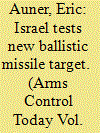

|
|
|
|
|
| Publication |
2013.
|
| Summary/Abstract |
Israel on Sept. 3 conducted the first flight test of a new missile defense target designed to improve Israeli defenses against longer-range ballistic missiles. The unannounced launch of the target, designed to simulate medium-range ballistic missiles like those possessed by Iran, was detected by Russian radar and reported in Russian media.
Israel, which initially claimed that it was unaware of a missile launch over the Mediterranean Sea after it was reported in the Russian media, said the test of the Silver Sparrow ballistic missile defense target was long planned. The Israeli Ministry of Defense issued a statement on its Facebook page saying that the missile defense radar successfully detected and tracked the launch and transferred flight data to the battle management system.
|
|
|
|
|
|
|
|
|
|
|
|
|
|
|
|
| 3 |
ID:
129860
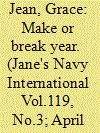

|
|
|
|
|
| Publication |
2014.
|
| Summary/Abstract |
Lead Littoral Combat Ship (LCS) USS freedom completed its maiden operational development in 2013. US future frigate plans may include a variation of the LCS design. Both LCS variants are in serial production. Despite all this, the US department of defence has announced the truncation of the programme.
|
|
|
|
|
|
|
|
|
|
|
|
|
|
|
|
| 4 |
ID:
128087
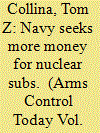

|
|
|
|
|
| Publication |
2013.
|
| Summary/Abstract |
Warning that ongoing defense spending cuts will have a "devastating impact" on its plans to build new ships, the Navy is asking Congress for an additional $60 billion over 15 years to pay for a dozen new nuclear-armed submarines. Testifying Sept. 12 before the House Armed Services Seapower Subcommittee, Rear Adm. Richard Breckenridge, the Navy's director of undersea warfare, said that the Navy's projected shipbuilding budget cannot afford to pay for the 12 new submarines, known as the SSBN(X). These new boats are to replace the existing fleet of nuclear-armed Ohio-class subs, which the Navy plans to start retiring in 2027. "Congress must look at a way to provide an annual supplement to the Navy" during the time that construction costs will peak, Breckenridge said. The Navy is seeking $4 billion per year over the 15-year period that the new subs would be built, starting in 2021. Breckenridge said that the SSBN(X) should be looked at as "a requirement above the Navy" that should be insulated from "the pressures of sequestration."
|
|
|
|
|
|
|
|
|
|
|
|
|
|
|
|
| 5 |
ID:
129852


|
|
|
|
|
| Publication |
2014.
|
| Summary/Abstract |
Failing to bolster the U.S. Navy in the face of 21st-century maritime threats could prove disastrous to the international order.
The year 2014 promises to be exceedingly important for the future of America's Navy. As the Pentagon and Congress face continued budget reductions and the Department of Defense is forced to weigh its priorities, the contours of American sea power and our global commitment to an expeditionary posture are at stake. Indeed, the choices made in just the next several years will lock in major trends in shipbuilding, naval aviation, and important research-and-development (R&D) efforts that will define the Navy of the 2020s and beyond.
American economic prosperity and national security have always been tied to the sea in some form. More than two centuries ago, George Washington wrote of the need, "as certain as that night succeeds the day," for effective sea power to achieve decisive military outcomes. Writing long before theorists like Alfred Thayer Mahan or Julian Corbett were heard from, Washington opined that success on land required superiority at sea. 1 Our nation's first foreign conflicts, the Barbary Wars at the dawn of the 19th century, were undertaken to secure global maritime trade against the scourge of international piracy. The growing U.S. ability to defend the maritime commons and project power abroad increased international respect for our fledgling nation and began America's ascent as a great power. Like Great Britain in an earlier era, the United States has used its maritime supremacy to construct an international order predicated on a commitment to unrestricted access to the global commons and deterrence of regional aggression
|
|
|
|
|
|
|
|
|
|
|
|
|
|
|
|
| 6 |
ID:
133085
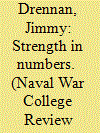

|
|
|
|
|
| Publication |
2014.
|
| Summary/Abstract |
You are a tactical commander tasked with a mission to seek out and destroy one of the enemy's premier capital ships in his home waters. You have two potential striking forces at your disposal: a world-class surface combatant of your own with a 99 percent probability of mission success (Ps = 0.99) or a squadron of eight independently operating, missile-carrying small combatants, each with a chance of successfully completing the mission no better than a coin flip (Ps = 0.5). Do you go with the almost sure thing and choose to send in your large combatant? As it turns out, the squadron of small combatants has an even higher overall Ps but let us now assume that you have advanced to operational commander. You might have more concerns than just overall Ps. What are the defensive and logistical requirements for each option? How much fleet investment are you risking with each option? What will it cost to replace the asset(s) if lost? What capability does the striking force have after successful enemy action (i.e., resilience)? An analysis of these factors, intentionally designed to disadvantage small combatants, is actually overwhelmingly in their favor. The results verify what naval strategists and tacticians have long known-that for certain offensive missions, an independently operating group of even marginally capable platforms can Naval War College Review Vol.67, No.1; Win.2014: p.119-124 Was there something unique to the Japanese that lost them the battle of midway?
|
|
|
|
|
|
|
|
|
|
|
|
|
|
|
|
| 7 |
ID:
129863
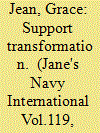

|
|
|
|
|
| Publication |
2014.
|
| Summary/Abstract |
As the US rebalances its strategic focus to the Asia - Pacific region, Military Sealift Command (MSC) is reassessing how it can batter support the forward deployed fleet, while contending with expending mission sets and budgetary constraints.
|
|
|
|
|
|
|
|
|
|
|
|
|
|
|
|
|
|
|
|
|